Make Math Meaningful with Picture Books
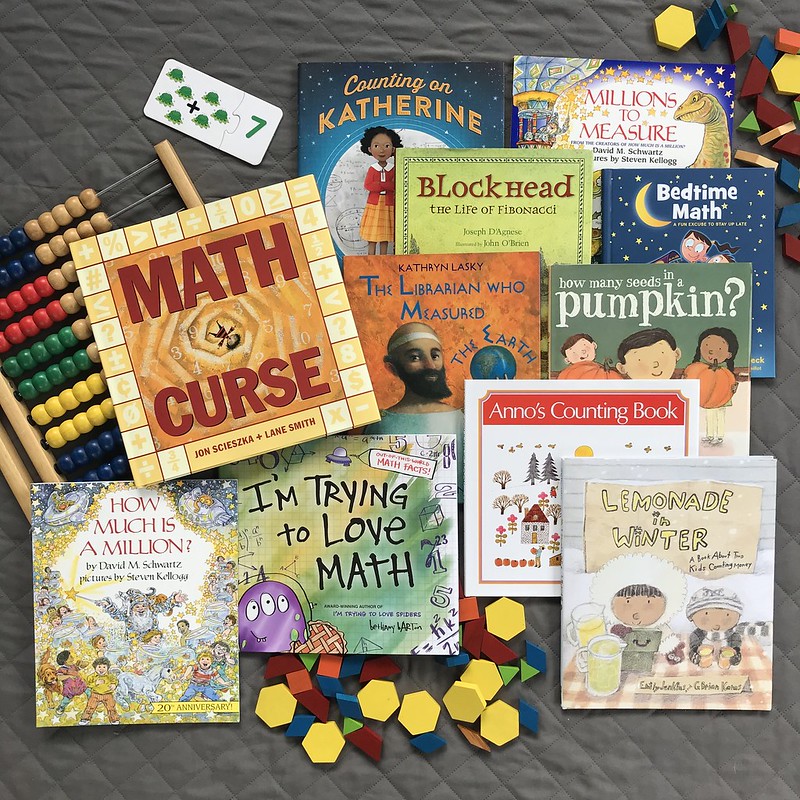
Stories stick and that makes them a great educational tool. Facts are more easily and accurately remembered when they are part of a story and there is no shortage of facts when it comes to math! In this blog, let’s talk about how using picture books can make learning math more fun and meaningful. We all know that a well-written homeschool curriculum is invaluable and as our children move through their homeschooling years, reading books does tend to give way to more curriculum. There is, however, nothing quite like the gentle learning that happens as you curl up on the couch and read books with your children; especially in the younger years. Using math books in the early years will help fill your children with mathematical facts and concepts in a fun and engaging way long before you have to set them in front of their first math textbook. In fact, without much thought, we give our children years of stories and special times before we ever sit them in front of a grammar textbook. What would happen if we were purposeful in cultivating an interest in math by using books, baking, games, projects, and money activities before they ever had to work through a math text? I’ve really enjoyed reading through these math picture books with my children. We use them as part of our morning time, and they are bringing math to life. I’m regularly negotiating with my reluctant learner but he’s always up for a good story; even a math story. Math picture books help children make connections between math concepts and the real world, they introduce students to math vocabulary and math heroes, and they combine literacy skills with math. Many times my reluctant learner has literally disappeared under the table as I’ve encouraged him to answer the math questions in his workbook but math questions that are asked as part of a story seem to fly under his radar and he’s happy to answer them. Here’s a great list of just some of our math picture books. They are full of facts, concepts and even encouragement and humour. You and your children will also be inspired by some math heroes, learn a bit about history, and enjoy some great artwork! Counting on Katherine Millions to Measure Blockhead Bedtime Math Math Curse The Librarian who Measured the Earth How Many Pumpkin Seeds How Much is a Million I’m Trying to Love Math Anno’s Counting Book Lemonade in Winter by Adrianne Curwen Adrianne is a wife to a public-school educator/administrator and a homeschooling Mama to seven children. She believes that we have a unique opportunity as homeschoolers to design individualized education that suits giftings, interests, and passions. She and her husband have used a blend of registered homeschooling, enrolment with independent DL schools, and participation in public trade school programs to design individualized programs for their children. She is passionate about using read-alouds, picture books, novels, and conversations to educate her children but also gets excited by the amazing homeschool-designed curriculum that’s out there. Adrianne is thrilled by her new role at Classical Education Books and is grateful to have an opportunity to learn something new. She is grateful, every day for her saviour, Jesus Christ, and has no greater joy than when she sees her most important missions field walk with Him.
Curriculum Spotlight – Christian Studies

The Bible contains the foundational stories of the Christian faith. The Christian Studies program is a kind of literature study of these stories. It is delivered in three parts. Book 1 The first is a K-2 enrichment book that is used with The Story Bible. This three-year program will read through all the Bible stories with the children once. Each lesson will review big words and ask comprehension questions. Book 2 The second part is for grades 3-5 and it covers the stories of the Bible in three years. This part is based on The Golden Children’s Bible. Each lesson covers Facts to Know, Comprehension Questions, Geography, Activities, and Memory Verses. Book 3 The third part is a one-year overview of the entire Bible. It can start at grade 6 and it relies on the student’s understanding of the stories of the Bible as they read through the Reader which has an overview of each book. The Student Guide will then review key people, terms, and geography, and an outline of each book. Common Questions Questions that commonly arise ask about the Bible storybooks that are used in this program. While the student and teacher’s guide refers to the required storybook pages, they also refer to the stories being taught. So one could use any story Bible to complete this course, but it would be best to use the recommended resources. These resources are the closest to the text that I’ve seen, which is one of the strengths of this program. Without getting theological, or imposing judgment on characters and situations, these texts faithfully tell the stories that are recorded in the Scripture. The course is a Bible literacy course, not a theological treatise or Bible study. It tells the story and helps the student remember the characters, time, and place. As such, it is a good resource for all Christians who want to know the Bible well, commit passages and texts to memory, and understand key phrases and words. Quick facts: Read through the Bible in three years with the K-2 Enrichment book Read through the Bible again in three years with the Christian Studies books I-III Read through an overview of the books of the bible with Christian Studies book IV Each part can be done independently of the other Bible story resource with parts 1 and 2 not required but it is strongly recommended This is a Bible literacy course, with memory verses required every week. Add in memory verse flashcards to help with memorization Learn the books of the bible and an outline of each book by the end of all 7 years Memorize 200+ trivia questions Create a timeline of events Can include maps of the geography for classroom or kitchen walls Grades are a recommended starting place, but it can be used in higher grade levels as well by Hester VanBraeden Hester is a second-generation home-educating parent who is keenly aware that her own education is not complete, and comfortable that it probably never will be. She has many years of experience with children, books, and curriculum. She loves to travel to worlds and times beyond the present with her children through many books. Hester and her husband have four children and live in the lower mainland of BC.
Teach Through April Book Stack
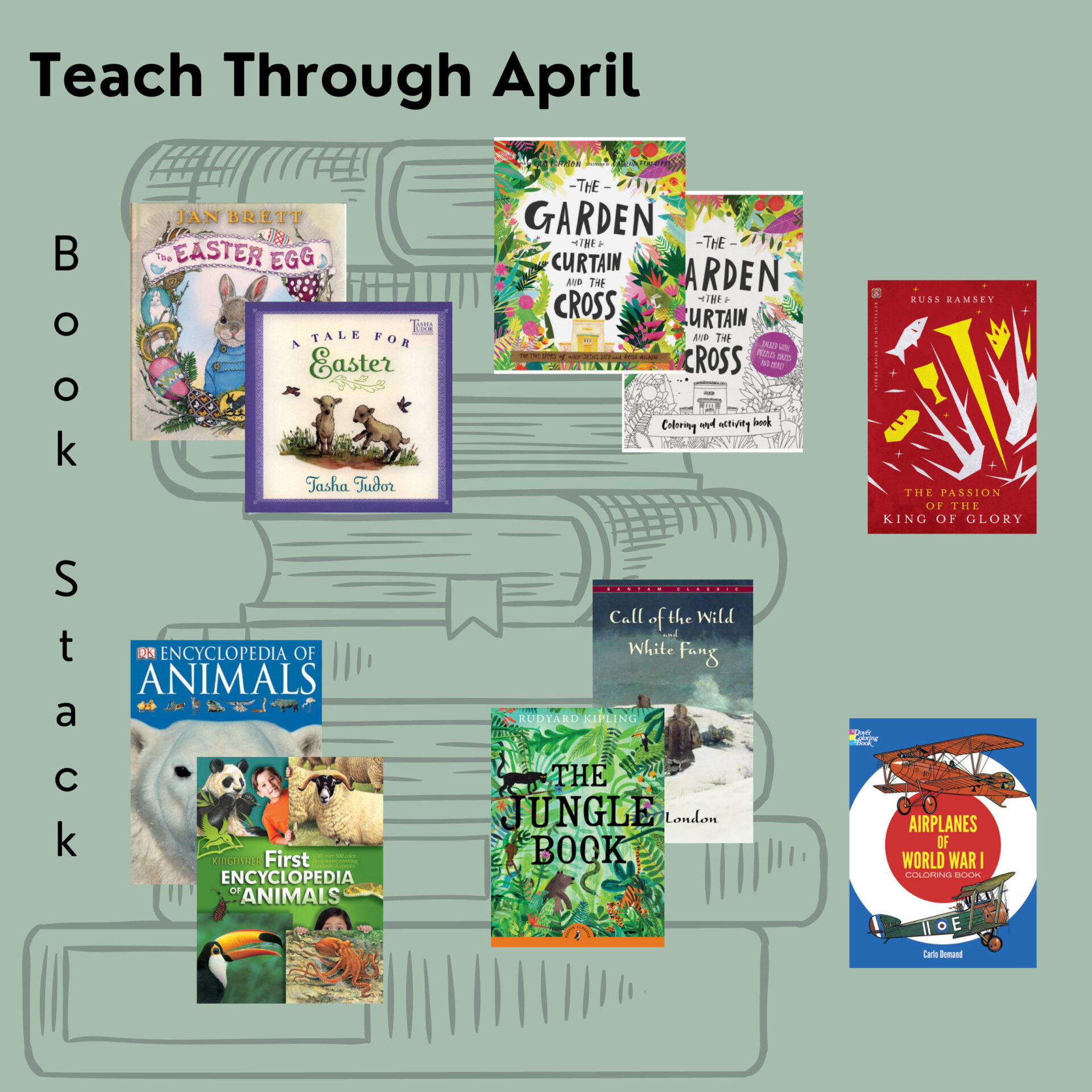
Easter Weekend – April 2nd-4th The Easter Egg A Tale for Easter The Garden, the Curtain, and the Cross The Garden, the Curtain, and the Cross – Coloring and Activity Book The Passion of the King of Glory National Wildlife Week – April 4th-10th Encyclopedia of Animals Kingfisher First Encyclopedia of Animals Call of the Wild and White Fang The Jungle Book Vimy Ridge Day – World War I – April 9th Airplanes of World War I – Coloring Book
Book Stacks – Katie Books

Subjects that are seen as “extra-curricular” can be the first to slide when life gets busy and sadly, I am guilty of this. You don’t have to look very far to find research that will encourage you to make art a regular component of your homeschool life so I encourage you to think through how you will work it into your days. We have a selection of art curriculum that you can work through with your children but also consider taking the time to introduce your children to famous artists and their work. We have used several of these Katie books; they are a fun way to introduce your children to the art world. Add a package of watercolour pencils, paintbrushes, and a new watercolour art book and you have the ingredients for making beautiful homeschool memories. Katie and the Mona Lisa Katie and the British Artists Katie and the Waterlily Pond Katie’s Picture Show Katie and the Bathers Katie and the Starry Night by Adrianne Curwen Adrianne is a wife to a public-school educator/administrator and a homeschooling Mama to seven children, ranging in age from 7 to 23. She believes that we have a unique opportunity as homeschoolers to design individualized education that suits giftings, interests, and passions. She and her husband have used a blend of registered homeschooling, enrolment with independent DL schools, and participation in public trade school programs to design individualized programs for their children. She is passionate about using as many read-alouds, picture books, novels, and conversations to educate her children but also gets excited by the amazing homeschool-designed curriculum that’s out there. Adrianne is thrilled by her new role as Communication Specialist for Classical Education Books and is grateful to have an opportunity to learn something new. She is grateful, every day, for her saviour, Jesus Christ, and has no greater joy than when she sees her most important missions field walk with Him.
Bible Storybook Stack
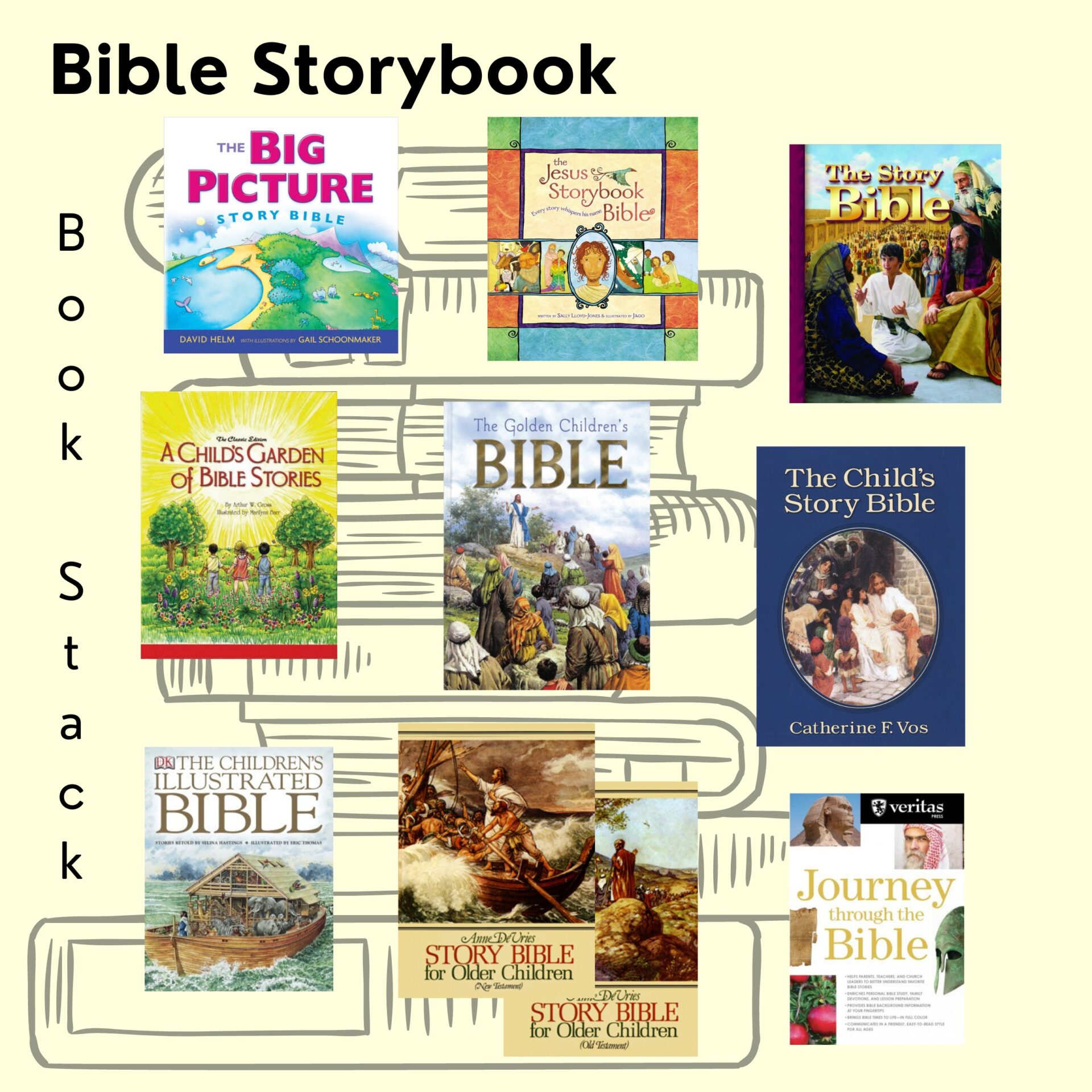
We have used several of these Bible Storybooks over the years and it would be a challenge to pick a favourite. It’s important that our children hear the bible read to them on a regular basis as hearing the words, wisdom, and instruction over the years builds a strong foundation. What at times seems to be information that is beyond young ones does build over time. A solid bible storybook is another tool we can use to build a solid foundation. They help young ones access wisdom and truth early in their lives and they give a high-altitude view of the bible, using stories as a way to communicate. As well, cycling through these stories year after year becomes the basis for more advanced learning, making these great resources for the grammar stage of learning. The Big Picture Story Bible The Jesus Storybook Bible The Story Bible A Child’s Garden of Bible Stories The Golden Children’s Bible The Child’s Story Bible The Children’s Illustrated Story Bible Story Bible for Older Children – Old Testament Story Bible for Older Children – New Testament Journey Through the Bible
Spring Book Stack
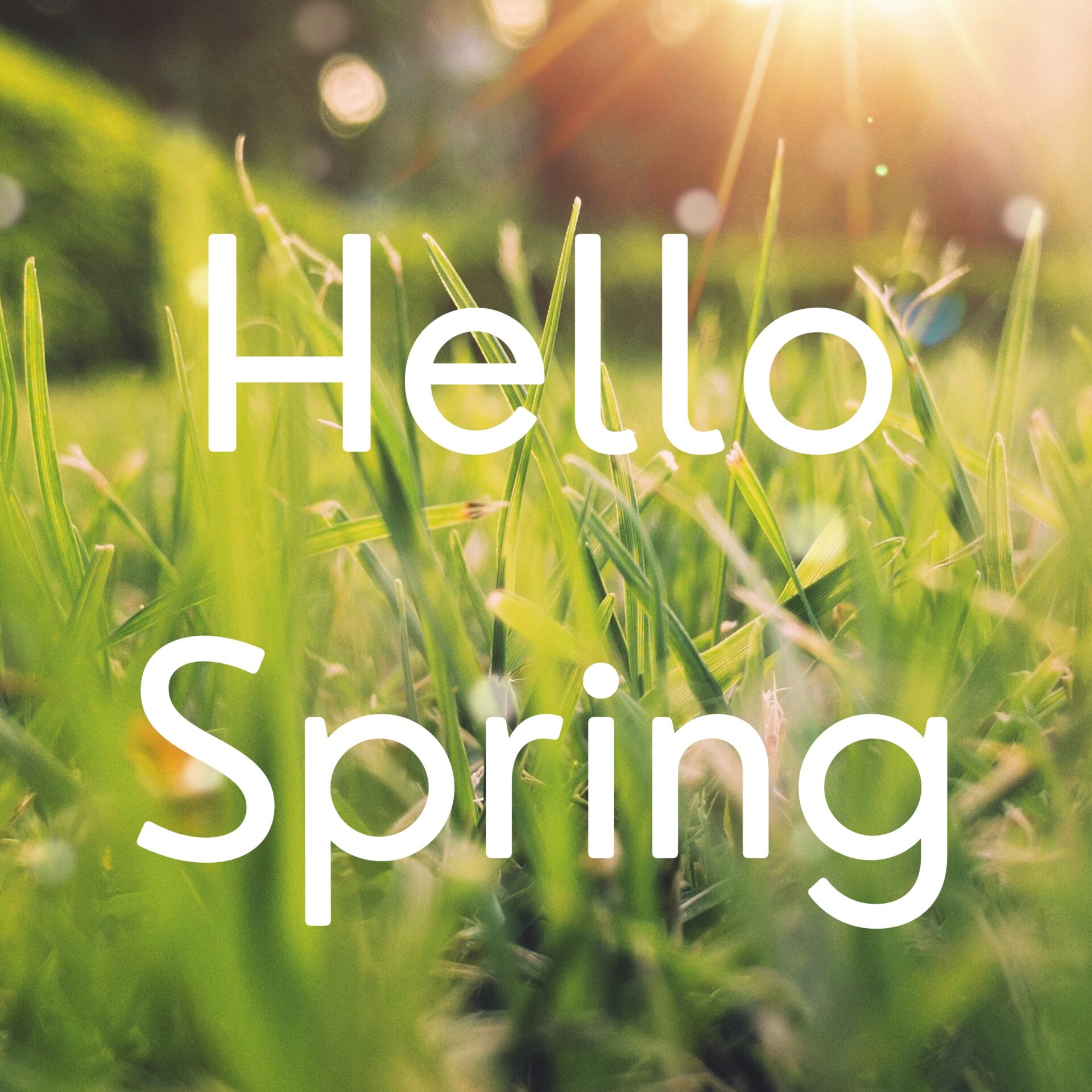
It’s March and I live in British Columbia so when I look out my window it’s spring. I have a favorite season but overall, I simply get excited about the changes that all the seasons bring. A new season naturally brings changes to weather, wardrobe, and activities but I like to purposefully exhaust as many changes as possible right down to the resources we use for our homeschooling: pumpkin picture books in October and Christmas books in December. Now is the time to scour your shelves for all things spring and we’ve compiled a stack of resources that would make great additions to your springtime learning. Coloring Books Don’t let the fact that these are coloring books fool you, they are full of more than just coloring. Your children will learn a lot as they read through these pages and be inspired to learn more. They are a great starting point for some springtime learning. Forest Animals My First Book About Backyard Nature Backyard Nature Coloring Book Picture Books You might still need a blanket but these picture books about nature would make great read alouds as you sit outside enjoying the change of season. I have to be so purposeful to get outside in the winter months but that all changes once springtime rolls around. We eat outside, read outside, and work through our morning time routine outside. Wangari Maathai Stellaluna The Gift of the Tree The Rainforest Grew All Around We’re Sailing to Galapagos Have You Seen Birds? Wonders of Nature Novels and Nature Stories All of the reading here has a spring/nature theme. Use the links below to see a full description of each title. The Penderwicks in Spring Come To My Tomorrowland The Burgess Bird Book for Children Outdoor Secrets Jack’s Insects We hope you are excited about the appearance of spring, but we also know that the events of life can cause the darkness of winter to take root where it is not welcome. Know that the CEB team is here to help you navigate through your homeschooling journey no matter what season you wake up to today. by Adrianne Curwen Adrianne is a wife to a public-school educator/administrator and a homeschooling Mama to seven children, ranging in age from 7 to 23. She believes that we have a unique opportunity as homeschoolers to design individualized education that suits giftings, interests, and passions. She and her husband have used a blend of registered homeschooling, enrolment with independent DL schools, and participation in public trade school programs to design individualized programs for their children. She is passionate about using as many read-alouds, picture books, novels, and conversations to educate her children but also gets excited by the amazing homeschool-designed curriculum that’s out there. Adrianne is thrilled by her new role as Communication Specialist for Classical Education Books and is grateful to have an opportunity to learn something new. She is grateful, every day, for her saviour, Jesus Christ, and has no greater joy than when she sees her most important missions field walk with Him.
Book Stack – Gail Gibbons Solar System
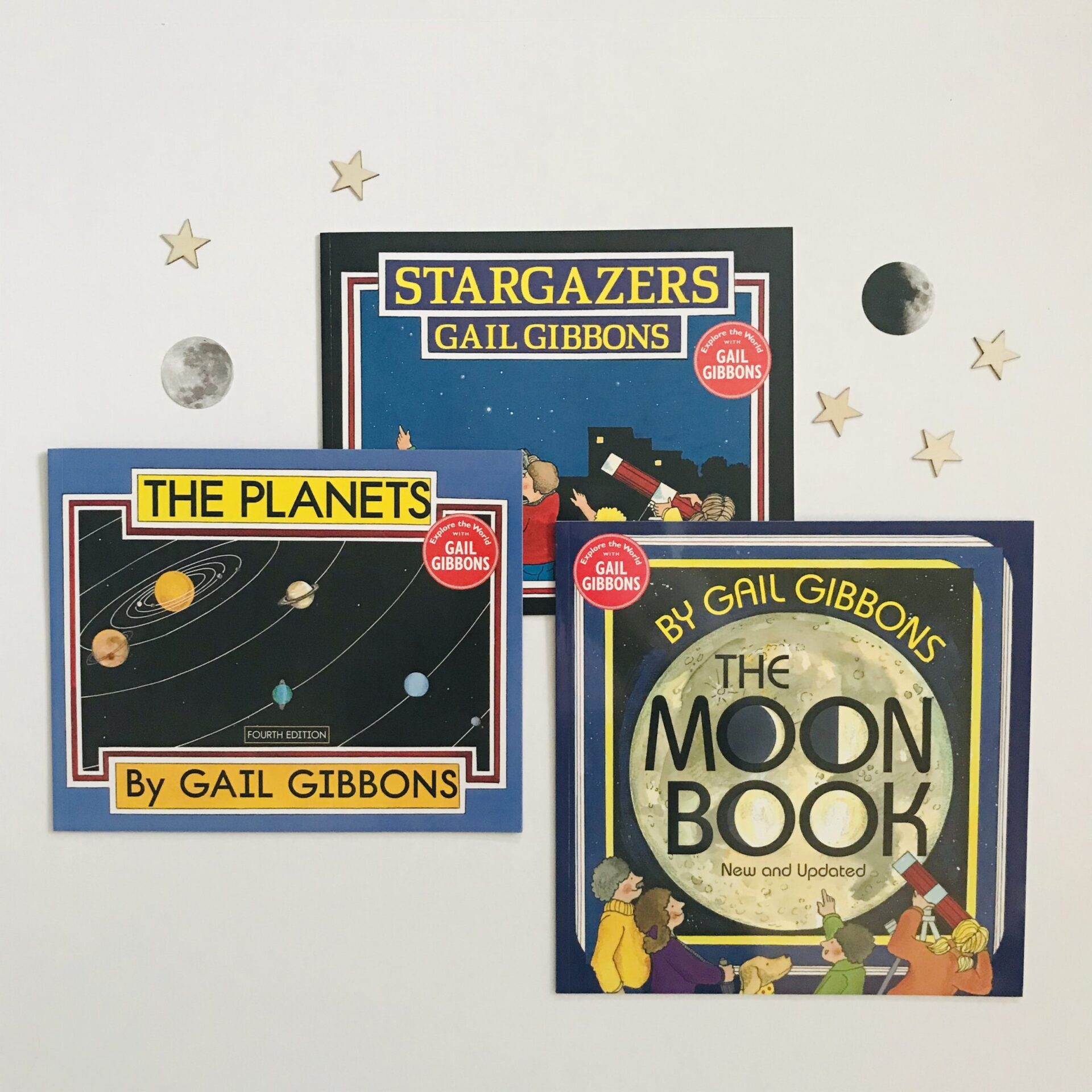
Gail Gibbons books are a favourite amongst homeschoolers and this trio is packed with information and great pictures. We’ll be adding to our Solar System unit this year with some colouring pages, notebooking pages, and of course constructing the solar system is a classic homeschool activity. We’ve used balloons, lego, or playdough over the years but I’m planning to try using painted rocks next. Also, there are some pretty cool apps that you can download onto your phone to make looking at the night sky pretty exciting. It all starts with reading aloud to your children; a foundation that can’t be understated and really can stand on its own. The Planets Stargazers The Moon Book by Adrianne Curwen Adrianne is a wife to a public-school educator/administrator and a homeschooling Mama to seven children, ranging in age from 7 to 23. She believes that we have a unique opportunity as homeschoolers to design individualized education that suits giftings, interests, and passions. She and her husband have used a blend of registered homeschooling, enrolment with independent DL schools, and participation in public trade school programs to design individualized programs for their children. She is passionate about using as many read-alouds, picture books, novels, and conversations to educate her children but also gets excited by the amazing homeschool-designed curriculum that’s out there. Adrianne is thrilled by her new role as Communication Specialist for Classical Education Books and is grateful to have an opportunity to learn something new. She is grateful, every day, for her saviour, Jesus Christ, and has no greater joy than when she sees her most important missions field walk with Him.
Curriculum Spotlight – Center for Lit

The Center for Lit has done something amazing for teaching literature. You don’t need textbooks or analytical reviews. You just need to know how to ask the right questions. Their flagship product, Teaching the Classics is an eight-hour seminar for parents, teachers, and readers. It gives them a tool for reading literature that acts like a pair of glasses which are to be worn whenever you read a book. This method shows how every story has the same structure, and it provides a long list of questions that will equip the teacher or parent to begin a Socratic Dialogue. By using dialogue a teacher can help the student engage with the story in a way that challenges his own views and opinions, rather than asking the student to assess a story whereby he just applies his paradigm to the text. Teaching the Classics also reviews literary devices and their importance to understanding classic literature. This program is for all grades and beyond. In fact, it’s easiest to start to learn how to teach with dialogue using kids’ picture books. A shorter story means less that gets in the way of spotting the key elements. But we can use this with texts as complex as Tolstoy or Tolkien. Beyond the seminar, the only thing you need is a desire to learn, and a good book. Once you have completed the seminar, Center for Lit helps us choose books for each grade level in their book Read Roadmaps. This guide also gives us a summary of each book and short notes for the teacher as tips for Socratic dialogue. If you want to have complete lesson plans for select books, you can use the Ready Readers. The Ready Readers Series have texts for Elementary to High School, even one for The Chronicles of Narnia. Each Reader provides several lessons for each book and they cover specific questions mapped out for the teacher, all within the scope of what was discussed in the seminar Teaching the Classics. You must watch the seminar to understand the scope of what these books are doing. I highly recommend the Ready Readers as a reliable support for teaching literature in the form of a Socratic dialogue. Quick Facts: Teaching the Classics is the central piece of this program. It’s all you need. Teaching the Classics is a DVD seminar with a workbook that can be done as a group. You will need to purchase additional workbooks for each viewer. Reading Roadmaps is a K-12 booklist with summaries of Teaching the Classics story chart. Ready Readers are open and go lesson plans for selected titles. This method can be used on any text, you do not have to use the Reading Roadmaps or the Ready Readers. by Hester VanBraeden Hester is a second-generation home-educating parent who is keenly aware that her own education is not complete, and comfortable that it probably never will be. She has many years of experience with children, books, and curriculum. She loves to travel to worlds and times beyond the present with her children through many books. Hester and her husband have four children and live in the lower mainland of BC.
Classical Education: Back to Basics

Classical education is a new term for an old path. Over the last several years it is being rediscovered. It’s the classic path, the path that was well travelled but somehow our adventurous natures took us beyond that path. As we try to rediscover how our Western Culture gave us a richness of beauty, truth and goodness that we have not been able to replicate in recent years, it turns out we’re in for a bit of a journey. This journey is presented in many different ways, styles and methods. Classical Education: Way Back When I’d like to take you back to a time before the phrase “classical education” emerged. Way back to the time when communication between human beings was primarily oral, or speaking. Some people were beginning to create systems of writing where words could be put down in a concrete, tangible ways. But it was not easy to do, so only the most important, or valued words were set down in a way that could exist outside of the human mind. Many of the texts that we have from that beginning are a good source for us to learn about who we are as human beings, but also how human beings have behaved and how or if that has changed. We need to pay special attention to some of the civilizations that existed before the birth of Christ such as the Greek, Roman, and Jewish cultures. These are three cultures whose words were put in written form and passed through the ages. When we take a closer look we will see that, as some of the first recorded thinkers, they presented foundational truths that have been built upon. To be fair, it’s not easy to take a few thousand years of history and boil it down to into a neat little summary. However, like a valiant student of the subject who can’t always distinguish between brash and brave, I’ll delve in with you and take to heart what G.K. Chesterton said: “If a thing is worth doing, it’s worth doing badly.” And I believe so strongly that it’s worth learning about our past because I believe that there is no other way to change our future. So let’s give this a try. Some Truth and Good Ideas The Greek civilization was keen to look at man as more than a physical phenomenon. Through the works of Plato we learn that man is more than a body; more than what is visible to the eye. Plato tells us about another part of man which we know to be the soul. He goes on, at tedious length I might add, to discuss what that means, and how a man can take control of his actions and become self-governed. He explains to us that to become more human, man must learn to conduct himself in a way that benefits the greater good, and the wider community of mankind. While all these ideas resonate with us, we feel something lacking. That’s because there was a major piece missing in Greek thought which became evident when, despite their efforts to be man in perfection, they were invaded by a barbarian horde who became their rulers. Some of the barbarian hordes listened to the ideas that the Greeks had put forward, and these ideas resonated with them too. As a result, they tamed their wild natures to be able to get along for the greater good of the community, or you could say they learned to be civil. And thus, we come to one of history’s greatest civilizations, the Roman Empire. The Greek ideas became the teachers in this new order, and the idea of a self-governed man became alive as the civilization began to set up structures to rule over other people. The self-governed man was learning to rule as a governor of many men, but also how to live under a governor or many governors as good citizens. As a result of their thoughts and actions, they were able to extend their rule over less governed people and barbarians became civilized. An Unavoidable Problem As lovely as it might sound, this was not the utopia that man was longing for. Self-government and learning to live under man’s rule as a good citizen did not work out the way it had been planned. While many Romans were courageous and lived honorable lives, there were many cowardly and dishonest Romans. So it’s fair to ask the question: if these ideas are so great why was Greece conquered? Why did Rome fall? Because man cannot be the perfectly self-governed individual. We know that this is true because before Plato ever drew breathe, a man named Moses lived. He was the leader of a small tribe of ex-slaves, wandering like nomads in the desert. Moses famously ascended a mountain to receive instruction from his God, the great YHWH. Moses received the powerful words spoken and etched into stone by YHWH for all the world to read: the two stone tablets of the law. He presented these words to his people and they scorned him. This Moses, beloved of YHWH, receiver of these great words was unable to contain his fully human anger towards the people. According to his God, the great YHWH that was the point. YHWH had been saying for many generations that His people could not keep these laws. But that didn’t stop Him from presenting the law to His people anyway, even after Moses destroyed the first copy deciding that the people were not worth of these great words. Jesus is the Answer So it was no small matter that, at the height of the Roman Empire, during the reign of one of Rome’s greatest governors, or Emperors, YHWH fulfilled his promise to take matters into His own hands and make everything right. He became man, in the form of a small baby, born in backwoods Jerusalem, far from the glory of Athens or Rome. This God-Man was to be the
Book Stacks – Drawing Books
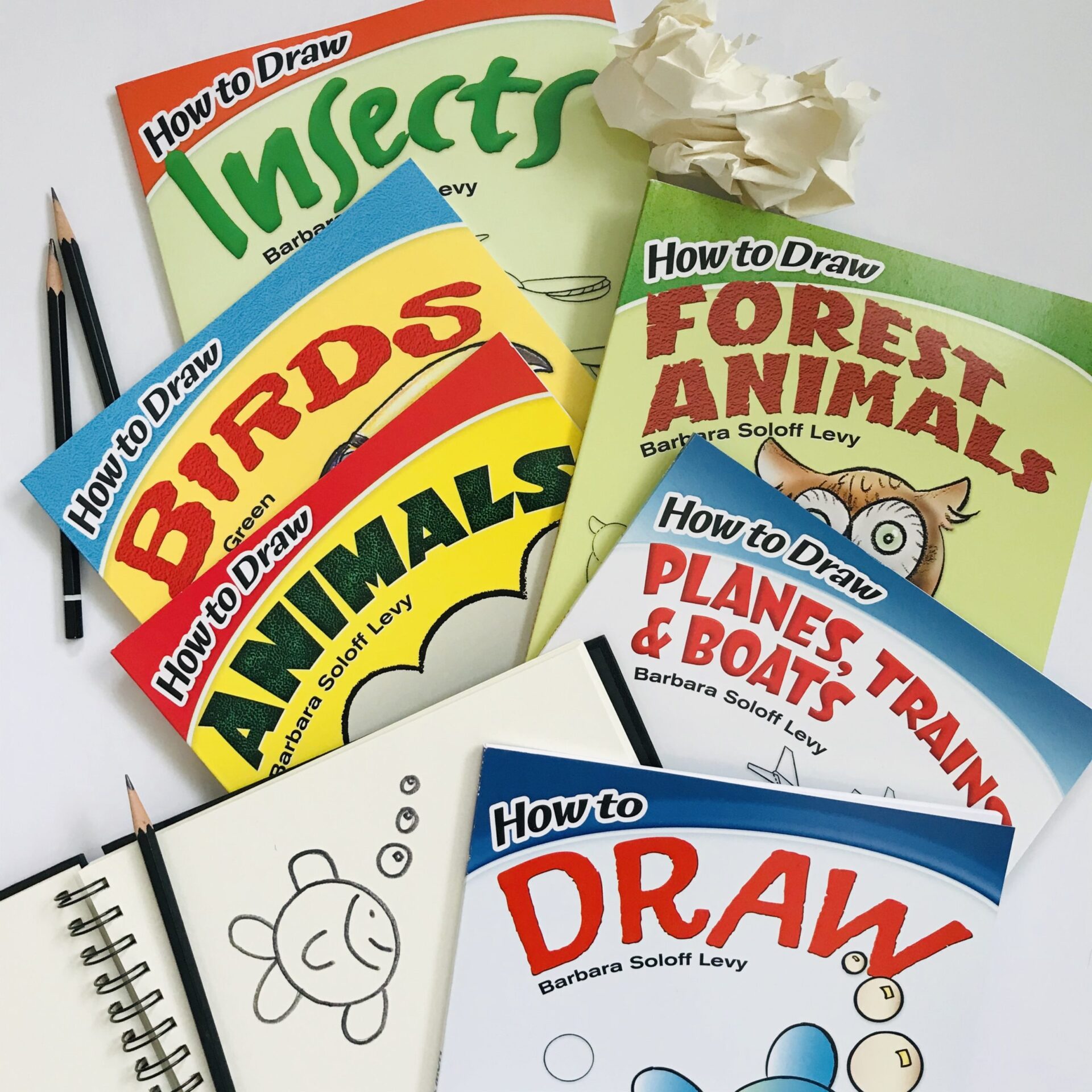
These drawing books are simple and fun. There are no written instructions, making these books a great starting point for young artists. Older artists, like, ahem, mom really appreciate these books too; they sure help with the skills that make Nature Studies more fun. Drawing books also make great additions to Morning Time. These books include practice pages but I prefer to pick up a sketchbook for each child to use just during Morning Time. It’s so fun for them to flip back and see the progress that’s been made. How to Draw Insects How to Draw Birds How to Draw Animals How to Draw Forest Animals How to Draw Planes, Trains, and Boats How to Draw by Adrianne Curwen Adrianne is a wife to a public-school educator/administrator and a homeschooling Mama to seven children, ranging in age from 7 to 23. She believes that we have a unique opportunity as homeschoolers to design individualized education that suits giftings, interests, and passions. She and her husband have used a blend of registered homeschooling, enrolment with independent DL schools, and participation in public trade school programs to design individualized programs for their children. She is passionate about using as many read-alouds, picture books, novels, and conversations to educate her children but also gets excited by the amazing homeschool-designed curriculum that’s out there. Adrianne is thrilled by her new role as Communication Specialist for Classical Education Books and is grateful to have an opportunity to learn something new. She is grateful, every day, for her saviour, Jesus Christ, and has no greater joy than when she sees her most important missions field walk with Him.
Book Stack – Grammar Picture Books
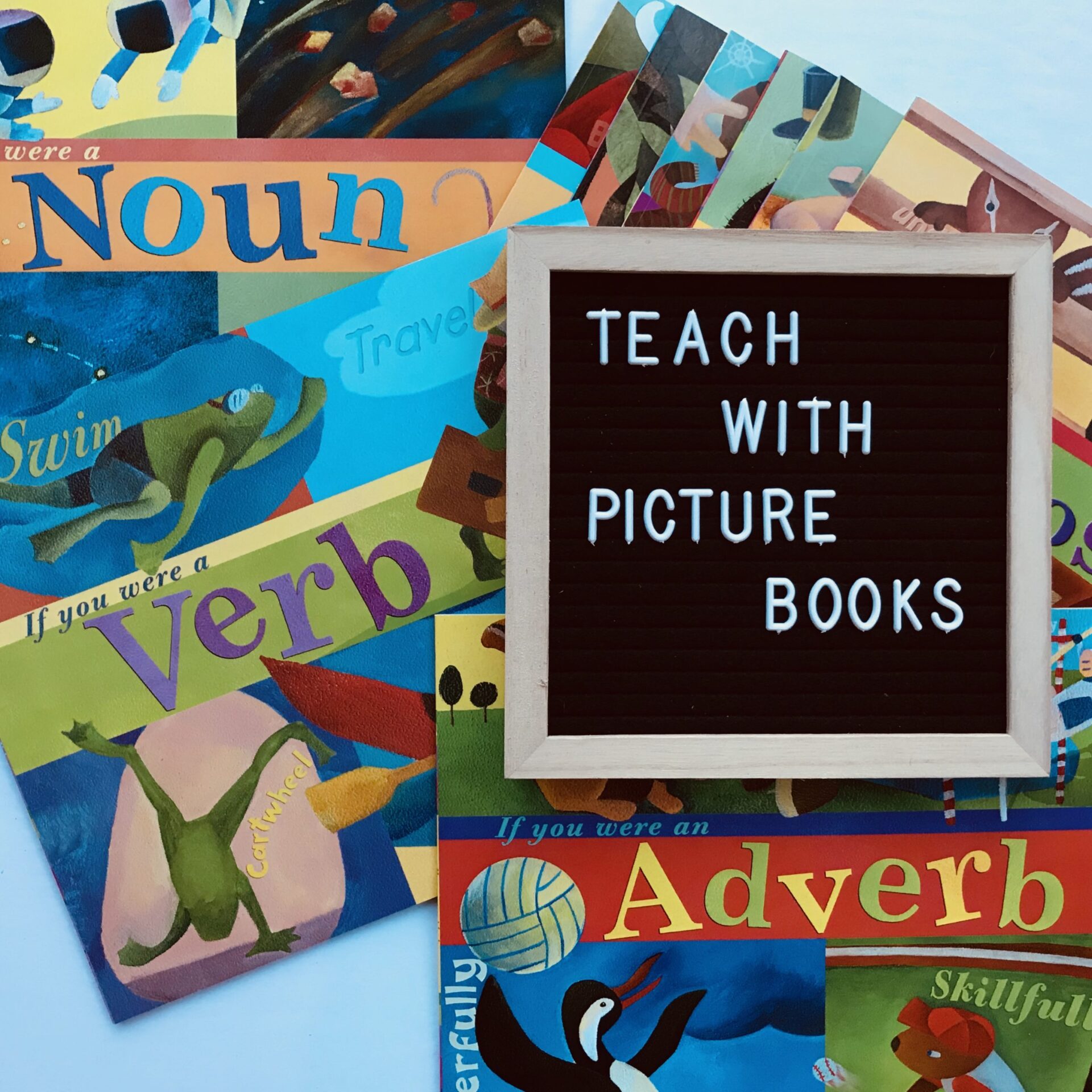
Picture books are a wonderful way to introduce your children to all kinds of topics. The selection of quality picture books is amazing and reading aloud to your children is such a natural and gentle way for your children to learn. I can’t encourage you enough to be purposeful in carving out a designated read-aloud time every day. If Morning Time or a Morning Basket is already a part of your regular routine, these should be in there! (If you are not familiar with the concept of a Morning Basket, click here to link to a short video that will help you get started.) Cycling through these stories throughout the year will give your young children a solid grasp of basic grammar. My 7-year-old, who has not been introduced to any grammar concepts yet, had a clear understanding of nouns after the first read-through, and even my 9-year-old who has completed 2 years of formal grammar curriculum enjoyed these books. There is a suggested game at the end of each book that is simple and fun. Don’t dismiss big kids before you read one of these to a younger one; they work well as a simple review, and I found that my young ones enjoyed having the big ones participate in the game. Order a few to get started with but you’ll probably be back for more. If You Were a Noun If You Were an Adjective If You Were a Verb If You Were an Adverb If You Were a Preposition If You Were an Interjection If You Were a Conjunction If You Were a Homonym or a Homophone If You Were an Antonym by Adrianne Curwen Adrianne is a wife to a public-school educator/administrator and a homeschooling Mama to seven children, ranging in age from 7 to 23. She believes that we have a unique opportunity as homeschoolers to design individualized education that suits giftings, interests, and passions. She and her husband have used a blend of registered homeschooling, enrolment with independent DL schools, and participation in public trade school programs to design individualized programs for their children. She is passionate about using as many read-alouds, picture books, novels, and conversations to educate her children but also gets excited by the amazing homeschool-designed curriculum that’s out there. Adrianne is thrilled by her new role as Communication Specialist for Classical Education Books and is grateful to have an opportunity to learn something new. She is grateful, every day, for her saviour, Jesus Christ, and has no greater joy than when she sees her most important missions field walk with Him.

